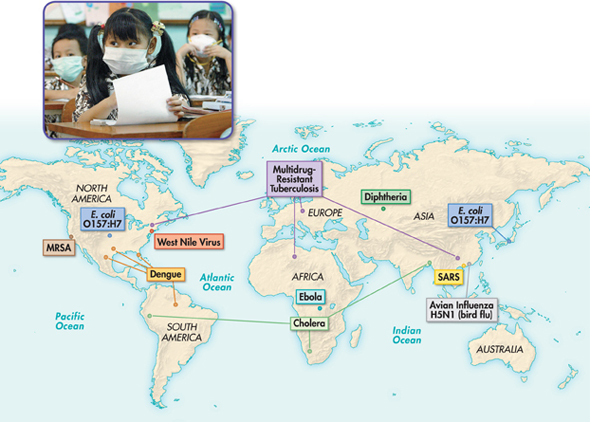Emerging Diseases
 Why are emerging diseases particularly threatening to human health?
Why are emerging diseases particularly threatening to human health?
If pathogenic viruses and bacteria were unable to change over time—that is, if they could not evolve—they would pose far less of a threat than they actually do. Unfortunately, the short time between successive generations of these pathogens allows them to evolve rapidly, especially in response to human efforts to control them. An unknown disease that appears in a population for the first time or a well-known disease that suddenly becomes harder to control is called an emerging disease.
Figure 20–19 shows locations worldwide where specific emerging diseases have broken out in recent years. Changes in lifestyle and commerce have made emerging diseases even more of a threat. High-speed travel means that a person can move halfway around the world in a day. Huge quantities of food and consumer goods are now shipped between regions of the world that previously had little contact with each other. This brings human populations that were once isolated by oceans and mountain ranges into close contact with more developed parts of the world. The possibility of the rapid spread of new diseases is a risk of every trip a person takes and every shipment of food or goods.
 The pathogens that cause emerging diseases are particularly threatening to human health because human populations have little or no resistance to them, and because methods of control have yet to be developed. Because of their sudden appearance and resistance to existing control methods, emerging diseases are of particular concern. Deeper understanding of the functions of the molecular structures and genetics of bacteria and viruses will be one key to defending against them.
The pathogens that cause emerging diseases are particularly threatening to human health because human populations have little or no resistance to them, and because methods of control have yet to be developed. Because of their sudden appearance and resistance to existing control methods, emerging diseases are of particular concern. Deeper understanding of the functions of the molecular structures and genetics of bacteria and viruses will be one key to defending against them.

FIGURE 20–19 Emerging Diseases In recent years, new diseases, such as severe acute respiratory syndrome (SARS) in Asia, have appeared. At the same time, some diseases thought to be under control have come back. Both examples are classified as emerging diseases. Interpret Graphics Which emerging diseases are found in Africa?
dTable of Contents
- Formulas and Equations
- Applying Formulas and Equations
- Mean, Median, and Mode
- Estimation
- Using Measurements in Calculations
- Effects of Measurement Errors
- Accuracy
- Precision
- Comparing Accuracy and Precision
- Significant Figures
- Calculating With Significant Figures
- Scientific Notation
- Calculating With Scientific Notation
- Dimensional Analysis
- Applying Dimensional Analysis




